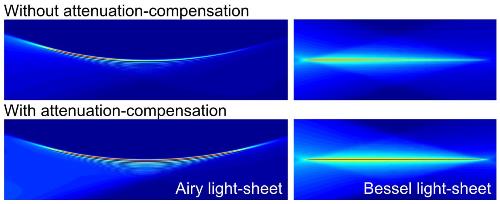An imaging technique that builds on Bessel beam based light-sheet microscopy and Airy beam based light-sheet microscopy could result in less intrusive and more effective diagnosis for patients.
The new method, published in Science Advances, allows light to be shaped so it can reach greater depths within biological tissue, enabling high quality three-dimensional (3D) images to be acquired. It can also allow detailed 3D images of biological specimens to be made without dissection or having to rotate specimens and take multiple images which are then fused together.
'We’ve recently discovered particular beam shapes that retain their shape when travelling through biological tissue. These beams, called Airy beams and Bessel beams resist the effects of scattering but they still become dimmer as they travel deeper, so it remains challenging to collect enough signal back through the tissue to form an image,' said Dr Jonathan Nylk of the School of Physics and Astronomy at the University of St Andrews in Scotland.
'Now we show that these beams can be further enhanced to give us more control over their shape, such that they actually get brighter as they travel (propagate). When the increase in brightness (intensity) is matched with the decrease in brightness (intensity) when travelling through tissue, a strong signal and a clear image can still be acquired from deep within the sample.'

Attenuation-compensated light-sheets reach greater depths. Credit: University of St Andrews
This latest research builds on previous advances in light-sheet imaging, in which a thin sheet of light cuts across the sample like a razor blade to section the sample – but without actually cutting or damaging it. The use of curved Airy light-sheets was shown to give sharp images over a volume ten times larger than previously possible.
The new techniques are expected be useful, not only for light-sheet microscopy, but also for pushing the limits of a whole range of other optical imaging techniques.
It is hoped that the development will lead to improved understanding of biological development, cancer, and diseases such as Alzheimer, Parkinson, and Huntington’s that affect the human brain.

